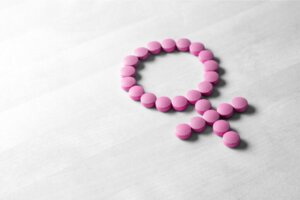What Are Estrogens and How Are They Produced?


Escrito y verificado por el biólogo Samuel Antonio Sánchez Amador
Estrogens are hormones that influence the growth, differentiation, and function of the organs of the reproductive system, such as the breasts, uterus, and ovaries. They also affect non-reproductive tissues, such as those located in the cardiovascular, skeletal, and nervous systems.
Hormones—usually proteins—are active in very small amounts and concentrations and cascade influencing the functioning and responses of other cells. Although it may not seem like it, they condition our lives much more than we might initially think.
What is a hormone?
According to the National Library of Medicine of the United States, hormones are the messengers of the body of living beings. These organic molecules travel through the bloodstream to different parts of the body. They’re defined by the following characteristics:
- They’re involved in metabolism
- They’re released into the cell space
- They travel through the bloodstream to the target organ that contains receptors for them
- They affect tissues that may be far from the point of origin
- Its effect is directly proportional to its concentration
- Regardless of their concentration, the receptor that acts with them has to function correctly
The endocrine glands, which are special cell associations, are responsible for synthesizing and secreting hormones. The main ones are the thyroid, the pituitary, the pineal, the thymus, the adrenals, and the pancreas. All of them are included in the endocrine system.
More than 30 types of hormones control the physiological processes of the human being.

What are estrogens?
Broadly, these organic molecules can be defined as female-type steroidal sex hormones that are produced in the ovaries and placenta during pregnancy and, to a lesser extent, in the adrenal glands.
From a chemical point of view, they’re derived from cholesterol, a lipid found in the cell membranes of eukaryotes, the body tissues of all animals, and the blood plasma of vertebrates. Despite its negative social connotations, cholesterol is essential to human physiology.
It should be noted that, in turn, certain estrogens derive from androgens, that is, from the male sex hormones. We found three different types, which we’ll summarize in the following lines.
1. Estrone
This is synthesized in the ovary and in adipose tissue from progesterone. Estrone, as we’ll see below, is the least abundant estrogen in the female body, since it’s present above all in postmenopausal women.
Also called E1, previously cited sources emphasize that this is the hormone produced after menopause. Estrone can be converted to estrone sulfate, a storage molecule that can be converted to its most active form under certain conditions: estradiol.
2. Estradiol
Called E2, estradiol is the predominant estrogen throughout the lives of fertile women and is obtained from testosterone, the male hormone par excellence. Estradiol has various functions:
- It plays a fundamental role in the puberty of women, since it allows the development of secondary sexual characteristics: breasts appear, the uterus, ovaries and fallopian tubes increase in size and pubic hair appears. It also promotes the secretion of vaginal mucus, essential for protection against pathogens.
- It produces an increase in the thickening of the endometrium to prepare it for a future pregnancy.
- It increases libido.
- It participates in lipid metabolism.
- It promotes the distribution of fat typical in the female sex, that is, a greater accumulation in the hips, thighs and breasts.
- Helps fix calcium in the bones, which protects them against fractures.
To put things in perspective, we’ll say that estradiol is 10 times more potent than estrone and about 80 times more potent than estriol. For this reason, it’s considered the most important estrogen of all.
It should be noted that, although it may not seem like it, estradiol also plays a role in the male sex. According to studies, this estrogen is produced in the Sertoli cells of the testicles with the function of preventing apoptosis (death) of sperm cells.
Men with genetic disorders in the sex chromosomes may have atypical levels of estradiol in their blood.
3. Estriol
Estriol is a metabolite of estradiol. Known as E3 is the estrogen that increases during pregnancy. Thus, the blood levels of this hormone indicate the state of the placenta and the fetus during the gestation process.
Beyond this clear function, it’s interesting to note that estriol is being investigated as a possible treatment for multiple sclerosis. Women with this pathology have been found to have a much lower rate of symptom relapse during the third trimester.
In addition, in clinical trials, non-pregnant women treated with estriol significantly decreased the rates of brain injury sustained. Although this drug is not yet approved, the preliminary research is certainly promising.
A woman excretes 1,000 times more estriol when she’s pregnant than when she isn’t.
Estrogens in the clinical world
So, we can summarize that estrogens are types of hormones produced by the body that help develop and maintain feminine characteristics and the formation of long bones, among many other things, as indicated by the National Cancer Institute.
Even so, estrogens can also be produced in laboratory conditions, as they’re used as contraceptives in the treatment of symptoms against menopause, osteoporosis, menstrual disorders, and other conditions.
1. The estrogen test
As indicated by the United States National Library of Medicine, estrogen tests are necessary for the following events:
- Find out the reason for early or late puberty in girls and in boys about to enter adolescence.
- Diagnose menstrual problems.
- Find out the cause of infertility in women.
- Monitor infertility and menopause treatments.
- Finding tumors that encourage the overproduction of estrogen.
- Diagnose certain defects of the fetus during pregnancy.
- Monitor high-risk pregnancies with the estriol test.
In general, the method of obtaining it’s usually simple, since the amount of estrogens is quantified by means of a blood or urine test. Some professionals even choose to prescribe a home estrogen measurement test for the patient, which is done with a kit that analyzes saliva.
2. Clinical signs of low and high estrogen in women
In women, low estrogen levels can translate into menstrual periods that are less frequent or which stop completely, hot flashes, trouble sleeping, vaginal dryness, low sex drive, a worse mood, and dry skin. Some may also experience premenstrual migraines.
On the other hand, too high estrogen levels cause the opposite: weight gain, excessively copious periods, worsening of premenstrual syndrome, fibrocystic breasts, fibroids in the uterus, and feelings of anxiety or depression.
3. Clinical signs of low and high estrogen in men
The effects of estrogens in men aren’t so clear, since they don’t play such visible and relevant roles on them. A man with abnormally low estrogen levels may have excess abdominal fat and low sexual desire.
A man with too much estrogen in his blood, on the other hand, will experience significant breast enlargement (gynecomastia), poor erections, or infertility.

Beware of estrogen treatments!
As we’ve said before, estrogens are also used as drugs to modulate the effects of menopause and women’s menstrual cycles. This practice has come under scrutiny in recent years, as there’s evidence that some of these treatments could promote the appearance of certain types of cancer.
According to the American Cancer Society, estrogen-progestin therapy is linked to an increased risk of some types of breast cancer. In addition, the longer the treatment is extended, the greater the risks.
This same source informs us that 8 out of 10,000 women with this type of treatment will develop breast cancer. Although it’s a fairly low figure, it is by no means negligible nor should it be ignored.
Ovarian cancer is a more sensitive issue, because although it seems that women with estrogen treatments are more likely to suffer from it, the evidence isn’t strong to be able to confirm it. Even so, this type of treatment continues to be targeted and the preliminary evidence isn’t at all favorable.
Estrogens: a world of lights and shadows
As we have been able to observe along these lines, estrogens are necessary hormones for the development of living beings, especially if we focus our attention on the female sex. From the development of secondary sexual characteristics to bone strengthening and lipid metabolism, these molecules cover large and important functions.
Unfortunately, estrogen therapy is increasingly being questioned by contemporary medicine. This is because multiple pieces of evidence indicate that they could be related to the appearance of certain carcinogenic processes.
Estrogens are hormones that influence the growth, differentiation, and function of the organs of the reproductive system, such as the breasts, uterus, and ovaries. They also affect non-reproductive tissues, such as those located in the cardiovascular, skeletal, and nervous systems.
Hormones—usually proteins—are active in very small amounts and concentrations and cascade influencing the functioning and responses of other cells. Although it may not seem like it, they condition our lives much more than we might initially think.
What is a hormone?
According to the National Library of Medicine of the United States, hormones are the messengers of the body of living beings. These organic molecules travel through the bloodstream to different parts of the body. They’re defined by the following characteristics:
- They’re involved in metabolism
- They’re released into the cell space
- They travel through the bloodstream to the target organ that contains receptors for them
- They affect tissues that may be far from the point of origin
- Its effect is directly proportional to its concentration
- Regardless of their concentration, the receptor that acts with them has to function correctly
The endocrine glands, which are special cell associations, are responsible for synthesizing and secreting hormones. The main ones are the thyroid, the pituitary, the pineal, the thymus, the adrenals, and the pancreas. All of them are included in the endocrine system.
More than 30 types of hormones control the physiological processes of the human being.

What are estrogens?
Broadly, these organic molecules can be defined as female-type steroidal sex hormones that are produced in the ovaries and placenta during pregnancy and, to a lesser extent, in the adrenal glands.
From a chemical point of view, they’re derived from cholesterol, a lipid found in the cell membranes of eukaryotes, the body tissues of all animals, and the blood plasma of vertebrates. Despite its negative social connotations, cholesterol is essential to human physiology.
It should be noted that, in turn, certain estrogens derive from androgens, that is, from the male sex hormones. We found three different types, which we’ll summarize in the following lines.
1. Estrone
This is synthesized in the ovary and in adipose tissue from progesterone. Estrone, as we’ll see below, is the least abundant estrogen in the female body, since it’s present above all in postmenopausal women.
Also called E1, previously cited sources emphasize that this is the hormone produced after menopause. Estrone can be converted to estrone sulfate, a storage molecule that can be converted to its most active form under certain conditions: estradiol.
2. Estradiol
Called E2, estradiol is the predominant estrogen throughout the lives of fertile women and is obtained from testosterone, the male hormone par excellence. Estradiol has various functions:
- It plays a fundamental role in the puberty of women, since it allows the development of secondary sexual characteristics: breasts appear, the uterus, ovaries and fallopian tubes increase in size and pubic hair appears. It also promotes the secretion of vaginal mucus, essential for protection against pathogens.
- It produces an increase in the thickening of the endometrium to prepare it for a future pregnancy.
- It increases libido.
- It participates in lipid metabolism.
- It promotes the distribution of fat typical in the female sex, that is, a greater accumulation in the hips, thighs and breasts.
- Helps fix calcium in the bones, which protects them against fractures.
To put things in perspective, we’ll say that estradiol is 10 times more potent than estrone and about 80 times more potent than estriol. For this reason, it’s considered the most important estrogen of all.
It should be noted that, although it may not seem like it, estradiol also plays a role in the male sex. According to studies, this estrogen is produced in the Sertoli cells of the testicles with the function of preventing apoptosis (death) of sperm cells.
Men with genetic disorders in the sex chromosomes may have atypical levels of estradiol in their blood.
3. Estriol
Estriol is a metabolite of estradiol. Known as E3 is the estrogen that increases during pregnancy. Thus, the blood levels of this hormone indicate the state of the placenta and the fetus during the gestation process.
Beyond this clear function, it’s interesting to note that estriol is being investigated as a possible treatment for multiple sclerosis. Women with this pathology have been found to have a much lower rate of symptom relapse during the third trimester.
In addition, in clinical trials, non-pregnant women treated with estriol significantly decreased the rates of brain injury sustained. Although this drug is not yet approved, the preliminary research is certainly promising.
A woman excretes 1,000 times more estriol when she’s pregnant than when she isn’t.
Estrogens in the clinical world
So, we can summarize that estrogens are types of hormones produced by the body that help develop and maintain feminine characteristics and the formation of long bones, among many other things, as indicated by the National Cancer Institute.
Even so, estrogens can also be produced in laboratory conditions, as they’re used as contraceptives in the treatment of symptoms against menopause, osteoporosis, menstrual disorders, and other conditions.
1. The estrogen test
As indicated by the United States National Library of Medicine, estrogen tests are necessary for the following events:
- Find out the reason for early or late puberty in girls and in boys about to enter adolescence.
- Diagnose menstrual problems.
- Find out the cause of infertility in women.
- Monitor infertility and menopause treatments.
- Finding tumors that encourage the overproduction of estrogen.
- Diagnose certain defects of the fetus during pregnancy.
- Monitor high-risk pregnancies with the estriol test.
In general, the method of obtaining it’s usually simple, since the amount of estrogens is quantified by means of a blood or urine test. Some professionals even choose to prescribe a home estrogen measurement test for the patient, which is done with a kit that analyzes saliva.
2. Clinical signs of low and high estrogen in women
In women, low estrogen levels can translate into menstrual periods that are less frequent or which stop completely, hot flashes, trouble sleeping, vaginal dryness, low sex drive, a worse mood, and dry skin. Some may also experience premenstrual migraines.
On the other hand, too high estrogen levels cause the opposite: weight gain, excessively copious periods, worsening of premenstrual syndrome, fibrocystic breasts, fibroids in the uterus, and feelings of anxiety or depression.
3. Clinical signs of low and high estrogen in men
The effects of estrogens in men aren’t so clear, since they don’t play such visible and relevant roles on them. A man with abnormally low estrogen levels may have excess abdominal fat and low sexual desire.
A man with too much estrogen in his blood, on the other hand, will experience significant breast enlargement (gynecomastia), poor erections, or infertility.

Beware of estrogen treatments!
As we’ve said before, estrogens are also used as drugs to modulate the effects of menopause and women’s menstrual cycles. This practice has come under scrutiny in recent years, as there’s evidence that some of these treatments could promote the appearance of certain types of cancer.
According to the American Cancer Society, estrogen-progestin therapy is linked to an increased risk of some types of breast cancer. In addition, the longer the treatment is extended, the greater the risks.
This same source informs us that 8 out of 10,000 women with this type of treatment will develop breast cancer. Although it’s a fairly low figure, it is by no means negligible nor should it be ignored.
Ovarian cancer is a more sensitive issue, because although it seems that women with estrogen treatments are more likely to suffer from it, the evidence isn’t strong to be able to confirm it. Even so, this type of treatment continues to be targeted and the preliminary evidence isn’t at all favorable.
Estrogens: a world of lights and shadows
As we have been able to observe along these lines, estrogens are necessary hormones for the development of living beings, especially if we focus our attention on the female sex. From the development of secondary sexual characteristics to bone strengthening and lipid metabolism, these molecules cover large and important functions.
Unfortunately, estrogen therapy is increasingly being questioned by contemporary medicine. This is because multiple pieces of evidence indicate that they could be related to the appearance of certain carcinogenic processes.
- Hormonas, medlineplus.gov. Recogido a 3 de diciembre en https://medlineplus.gov/spanish/hormones.html#:~:text=Las%20hormonas%20son%20los%20mensajeros,Crecimiento%20y%20desarrollo
- Hormonas femeninas: estrógenos, Sanitas.es. Recogido a 3 de diciembre en https://www.sanitas.es/sanitas/seguros/es/particulares/biblioteca-de-salud/prevencion-salud/estrogenos.html
- Efectos físicos, emocionales y cognitivos del estradiol. Recogido a 3 de diciembre en http://webs.ucm.es/BUCM/tesis//19972000/S/4/S4014601.pdf
- Pentikäinen, V., Erkkilä, K., Suomalainen, L., Parvinen, M., & Dunkel, L. (2000). Estradiol acts as a germ cell survival factor in the human testis in vitro. The Journal of Clinical Endocrinology & Metabolism, 85(5), 2057-2067.
- El estriol como una opción de tratamiento potencial para la esclerosis múltiple, Mayoclinic.org. Recogido a 3 de diciembre en https://www.mayoclinic.org/es-es/diseases-conditions/multiple-sclerosis/expert-answers/estriol-as-a-treatment-option-for-multiple-sclerosis/faq-20110764
- Estrógeno, Instituto Nacional del Cáncer. Recogido a 3 de diciembre en https://www.cancer.gov/espanol/publicaciones/diccionario/def/estrogeno
- Prueba de estrógeno, medlineplus.gov. Recogido a 3 de diciembre en https://medlineplus.gov/spanish/pruebas-de-laboratorio/prueba-de-estrogeno/
- ¿Qué hace el estrógeno?, endocrine.org. Recogido a 3 de diciembre en https://www.endocrine.org/-/media/hormone/files/infographics/infographic_estrogen_sp_vertical.pdf?la=en
- Terapia de restitución de hormonas de la menopausia y el riesgo de cáncer, American Cancer Society. Recogido a 3 de diciembre en https://www.cancer.org/es/cancer/causas-del-cancer/tratamientos-medicos/terapia-de-restitucion-de-hormonas-en-la-menopausia-y-el-riesgo-de-cancer.html
Este texto se ofrece únicamente con propósitos informativos y no reemplaza la consulta con un profesional. Ante dudas, consulta a tu especialista.







